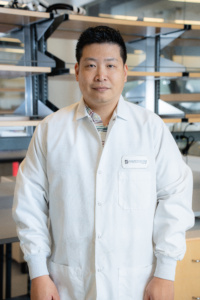Changho Han, Ph.D.
Drug Discovery Scientist II
| Sogang University, 2008 B.S. Chemistry, Life Science, Integrated Biotechnology |
|
| Purdue University, 2013 Ph.D. Medicinal Chemistry |
|
| Vanderbilt University, 2014 Postdoctoral Fellow, Medicinal Chemistry |
Phone: (615) 322-7415
Fax: (615) 778-1414
Email: changho.han@vanderbilt.edu
Location: Cool Springs Innovation Park

Mailing Address:
Vanderbilt University/WCNDD
Cool Springs Innovation Park
393 Nichol Mill Lane, Room 1001
Franklin, TN 37067
Biosketch and Research Interests
Changho has a broad background in general biology, synthetic organic chemistry, and medicinal chemistry. He has specific training experience and expertise in medicinal chemistry for getting therapeutics for neurological diseases and cancers. Throughout his carreer, he has been involved in multiple projects related to synthetic methodology development for biologically active molecule synthesis, early hit to lead development, and late lead optimization for pre-clinical development.
Changho earned his Ph.D. in medicinal chemistry from Purdue University in 2013, working on novel fluorination methodology (Colby Pro-Enolates) development under the direction of Dr. David A. Colby.
In 2013, Changho joined the Lindsley Lab as a Postdoctoral Fellow working on the synthesis of positive allosteric modulators (PAMs) for the muscarinic acetylcholine receptor M1 and M4 by utilizing iterative parallel synthesis approach.
In 2015, Changho joined the Fesik Lab as a Drug Discovery Scientist I, working on the synthesis of small molecule inhibitors of WDR5 by utilizing structure based design approach.
Changho’s research interests are in medicinal chemistry related for getting therapeutics for neurological diseases.
Selected Publications
Han C.; Chatterjee A.; Noetzel M.J.; Panarese J.D.; Smith E.; Chase P.; Hodder P.; Niswender C.; Conn P.J.; Lindsley C.W.; Stauffer S.R. ‘Discovery and SAR of muscarinic receptor subtype 1 (M1) allosteric activators from a molecular libraries high throughput screen. Part 1: 2,5-dibenzyl-2H-pyrazolo[4,3-c]quinolin-3(5H)-ones as positive allosteric modulators’ Bioorganic & Medicinal Chemistry (2015); 25(2): 384-388. {DOI: 10.1016/j.bmcl.2014.11.011; PMID: 25435150}
He S.; Senter T.J.; Pollock J.; Han C.; Upadhyay S.K.; Purohit T.; Gogliotti R.D.; Lindsley C.W.; Cierpicki T.; Stauffer S.R.; Grembecka J. ‘High-Affinity Small-Molecule Inhibitors of the Menin-Mixed Lineage Leukemia (MLL) Interaction Closely Mimic a Natural Protein-Protein Interaction’ Journal of Medicinal Chemistry (2014); 57(4): 1543-1556. {DOI: 10.1021/jm401868d; PMID: 24472025}
Han C.; Salyer A.E.; Kim E.H.; Jiang X.; Jarrard R.E.; Powers M.S.; Kirchhoff A.M.; Salvador T.K.; Chester J.A.; Hockerman G.H.; Colby D.A. ‘Evaluation of Difluoromethyl Ketones as Agonists of the γ-Aminobutyric Acid Type B (GABAB) Receptor’ Journal of Medicinal Chemistry (2013); 56(6): 2456-2465. {DOI: 10.1021/jm301805e; PMID: 23428109}
Han C.; Kim E.H.; Colby D.A. ‘Cleavage of Carbon-Carbon Bonds Through the Mild Release of Trifluoroacetate: Generation of α,α-Difluoroenolates for Aldol Reactions’ Journal of the American Chemical Society (2011); 133(15): 5802-5805. {DOI: 10.1021/ja202213f; PMID: 21443226}